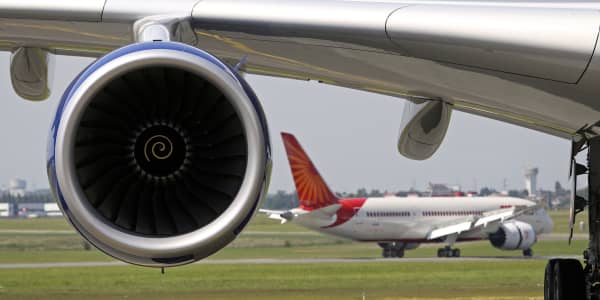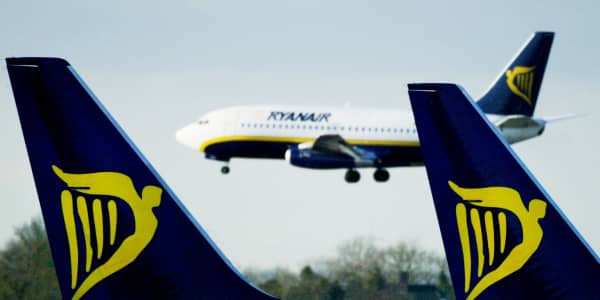While major airlines like United, Delta, Lufthansa and British Airways handle the largest number of passengers in the world, their growth remains either slow or stagnant as more and more low-cost carriers (LCC) seize sizable chunks of the aviation market.
So who are the rising stars of the airline business?
CNBC has compiled a list of the world's fastest growing airlines in terms of capacity numbers using the most recent data from Innovata, which measures airline capacity by available seat kilometers, and comparing the figures from December 2011 and December 2012.
The data reveal that LCCs are becoming bigger players in markets across the world, and according to the Centre for Aviation (CAPA) that trend is set to continue.
Click ahead for the world's 10 fastest growing airlines.
10. Virgin Australia
Passenger Increase 2011-2012: 18.3%
Virgin Australia made big gains in 2012, chipping away at rival Qantas's monopoly on many routes. The company also expanded its network and signed up several code-share deals. But the airline faces slower growth in 2013, as Australia's aviation industry deals with a slowdown in the resource-rich economy. The airline forecast capacity growth of only 4-5 percent over the next 12 months.
Air New Zealand recently upped its stake in Virgin Australia to 23 percent, something which will not have gone unnoticed by Etihad and Singapore Airlines - both of which have stakes in the company. Virgin Australia is now the second-largest airline down under and is a rare example of a company that has made the transition from LCC to full-service.
9. Emirates
Passenger Increase 2011-2012: 18.4%
Emirates continues to be one of the world's leading airlines in terms of size, service, and expansion - and has reported 25 consecutive years of profit. Earlier this month, it announced plans to increase its fleet of 200 aircraft by 25 percent over four years, with an additional 188 planes on order.
Ninety of these will be A380s - the world's largestpassenger aircraft. Emirates' vice-president for passenger sales worldwide,Thierry Antinori, said the airline is focused on larger planes and is not interestedin the smaller Boeing 787 model.
8. Norwegian
Passenger Increase 2011-2012: 22.5%
Norwegian is a low-cost carrier that is seeking to cash in on its success in Europe by expanding abroad.
It is currently the third largest low-cost airline in Europe, and the reason behind its growth is simple, according to Brendan Sobie, chief analyst at the Centre for Aviation (CAPA). "They established a new base in London recently, and in Europe you have an open market with the EU and can establish multiple bases. Norwegian has been aggressive in taking advantage of this, and later this year they are going to start long-haul flights too."
The airline has already started flying to New York and is planning to fly to Bangkok following the delivery of eight Boeing 787 Dreamliners that will service its long-haul flights.
Norwegian has become a serious competitor to SAS and FinnAir, and Norwegian's planned service from Oslo to Bangkok will fill a void left by SAS after it cancelled its Copenhagen-to-Bangkok service.
7. Turkish Airlines
Passenger Increase 2011-2012: 24%
Turkish Airlines has undergone a major revamp in recent years and is challenging the dominance of the Gulf carriers such as Emirates and Qatar.
Turkey's location certainly helps. "Their hub is similarly well-positioned to the Middle East airlines, well-positioned for Africa, Europe and Asia, and for getting into the smaller growth markets like Central Asia. They have emerged as a major airline that is carrying intercontinental passengers using Istanbul as a hub," CAPA's Sobie told CNBC.
That positioning is helping Turkish Airlines take advantage of North America, Africa and the Far East - all key growth areas.
6. All Nippon Airways
Passenger Increase 2011-2012: 24.3%
All Nippon Airways (ANA) turns sixty this year and holds a 50 percent market share in the Japanese market. The company has also launched its own low-cost airline called Peach. CEO Osamu Shinobe said the airline would continue to grow in the low-cost space while also boosting its international offerings.
The company's foray into the lower-cost segment has helped engineer a big shift in the company's corporate structure, according to ANA executives, who said seeing a simpler management system at budget airlines enabled them to speed up their own decision-making process.
5. Allegiant Air
Passenger Increase 2011-2012: 25.3%
U.S. airline Allegiant Air may have increased passenger numbers by almost a quarter, but it had the worst on-time rating of all U.S. carriers in 2012: more than 30 percent of its flights were late, according to FlightStats.com.
Like its rival Spirit, Allegiant focuses solely on the U.S. domestic market. It transports passengers from under-utilized airports to holiday hot-spots like Orlando, Honolulu and Las Vegas and has competition on only 17 of its 203 routes.
"They stick to smaller cities that nobody is really serving and they come in with low frequency (two flights a week) like Ryanair in Europe," CAPA's Sobie said. "They link these small cities with holiday destinations. They offer a product that nobody else offers."
4. Spirit Airways
Passenger Increase 2011-2012: 25.3%
American low-cost carrier Spirit recently hit the news for its decision to start selling $7 cans of wine on its flights. The airline is famous in North America for its low ticket prices - and subsequent charges for numerous add-ons.
Spirit's model focuses on a domestic no-frills market, rather than international expansion. Airline analyst Brendan Sobie said Spirit has deliberately avoided becoming a full-service airline. "These airlines (Spirit & Allegiant Air) have stayed true to the (low cost) model. They call themselves 'ultra-LCC,'" he said.
Sobie added that consolidation in the U.S had opened up certain domestic routes to carriers like Spirit. "Spirit has been growing for the last couple of years in major U.S. hubs like Chicago and Dallas."
"With a lot of consolidation and major mergers there have been opportunities in the domestic market including in the major hubs which used to be really competitive and hard to enter into."
3. IndiGo
Passenger Increase 2011-2012: 34.6%
IndiGo, an Indian low-cost carrier, is the only airline in the country to have reported a profit for the financial year 2012-2013.
The Centre for Aviation (CAPA) sees it increasing its profits, with international traffic for Indian carriers expected to grow by 10-12 percent as they expand into new markets.
IndiGo recently reached a 29.8% share of the Indian market, the highest since its 2006 launch, making it the largest airline in the country. Jet Airways (India), which used to be market leader, now has 22.6 percent of the market share.
2. Lion Air
Passenger Increase 2011-2012: 34.6%
Lion Air is the largest low-cost carrier in Indonesia and is hoping to expand beyond the domestic market, given its strong brand.
"It's a sleeping giant. It's one of the largest countries in the world and it has a very suitable geography for aviation: being an archipelago, you're not really competing with buses and trains, just ferries," CAPA analyst Sobie told CNBC.
A strengthening economy and growing middle class have also helped Lion Air. It's now looking to expand into Thailand, Malaysia and Australia.
"Lion Air continues to be one of the fastest growing airline groups in the world and they are very confident that will continue to grow extremely rapidly and they will be near or at the top of this list for years to come," Sobie added.
1. Vueling Airlines
Passenger Increase 2011-2012: 40.4%
Spanish budget carrier Vueling, a unit of national carrier Iberia, has been increasing the number of routes it flies in recent years. The airline is now a part of International Airlines Group (IAG), following the merger of Iberia and British Airways and the creation of the new company.
Willie Walsh, the CEO of IAG has said Vueling will be bigger than Iberia in three to five years, Reuters reported earlier this month.
Reuters quoting figures from Spain's airport authority Aena, said Vueling transported 5.7 million passengers in the first fourth months of the year, while Iberia and Iberia Express combined carried 5.6 million.




